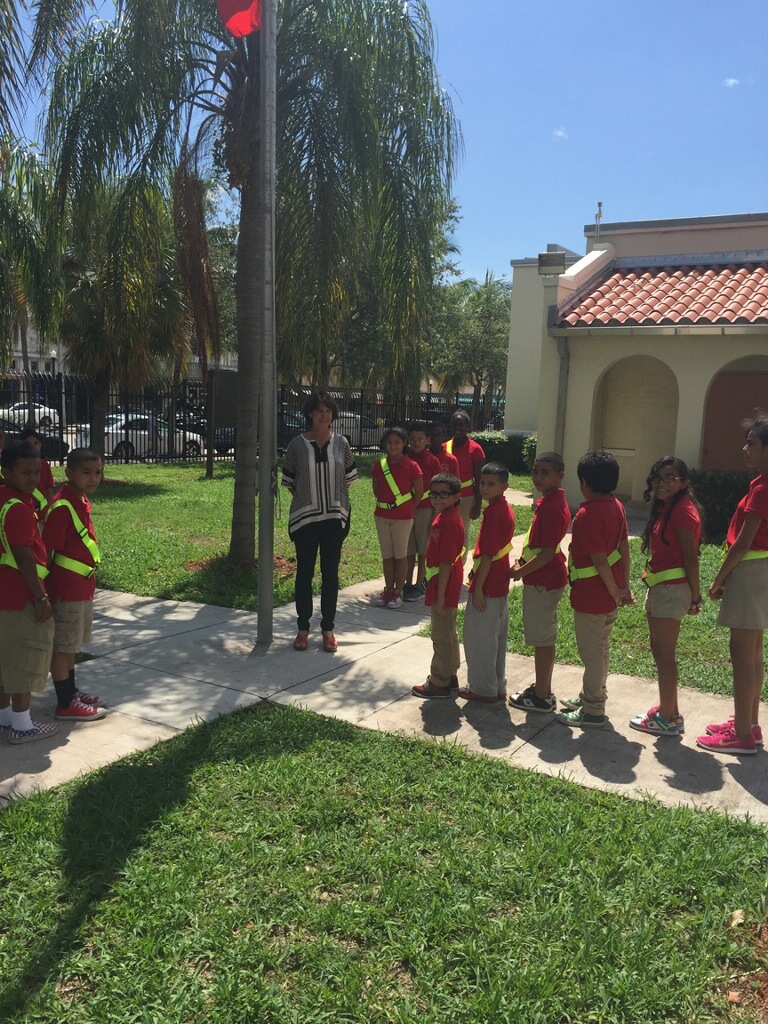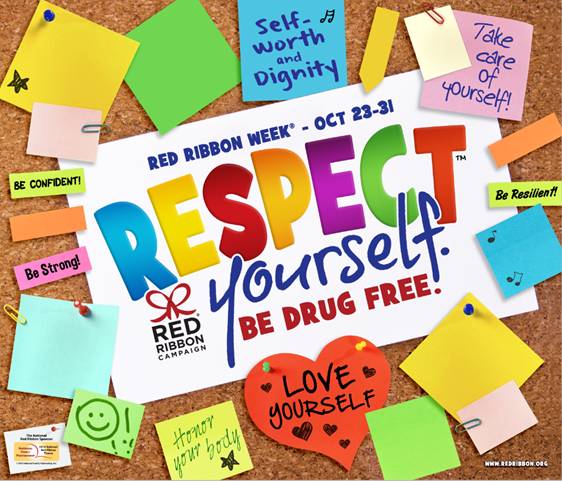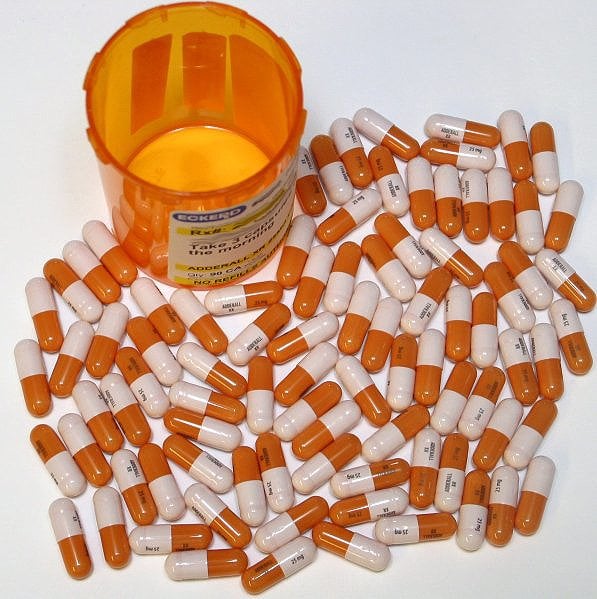Red Ribbon Certified Schools, a program of Informed Families and the National Family Partnership, recognizes schools that improve academic performance by keeping kids drug and alcohol free, while engaging parents and the community.
Informed Families Catalyst
Four Schools Honored With Red Ribbon Certification In 2015
Posted by Informed Families on October 15, 2015 at 3:07 PM
Topics: red ribbon week, prevention
Parents, Respect Your Children This Red Ribbon Week
Posted by Informed Families on October 8, 2015 at 1:54 PM
This year's Red Ribbon Week Theme is "Respect Yourself. Be Drug Free." The theme reminds us that when we respect ourselves, we make healthy choices that support our bodies and minds and enable us to reach our full potential.
To give you a little background, Red Ribbon Week is celebrated in over a hundred thousand schools nationwide, reaching an estimated 80 million individuals annually, bringing awareness and support for safe, healthy and drug free children in the United States and beyond. Between October 23rd and 31st each year, schools organize Red Ribbon Week activities and celebrations, from pep rallies and essay contests to decorating the school and hosting special assemblies with prevention professionals and local celebrities providing a drug-free message to children.
Topics: parenting, red ribbon, tips for talking with your kids about drugs
Peggy Sapp Appointed To FL Statewide Drug Policy Advisory Council
Posted by Informed Families on September 24, 2015 at 4:11 PM
Florida Governor Rick Scott appointed Informed Families President & CEO Peggy Sapp to Florida's Statewide Drug Policy Advisory Council.
"I'm honored to be selected to the Statewide Drug Policy Advisory Council," said Peggy Sapp. "I look forward to continuing to work together at the local, regional and statewide level to help kids grow up safe, healthy and drug free."
In addition to her work with Informed Families, Sapp is the Volunteer President of the National Family Partnership. She has over 30 years of experience in the prevention field at the local, state and national level and has served on the Advisory Councils of the White House Office of National Drug Control Policy and the National Institute of Drug Abuse. Under Governor Jeb Bush, Peggy also served on the advisory council of the Florida Governor’s Office of Drug Control.
Sapp's current term began September 18, 2015 and will end September 6, 2017.
Other newly appointed members of the Council include Dorothy “Dotti” Groover-Skipper, founder of HeartDance Foundation Inc; Doug Leonardo, executive director of BayCare Behavioral Health; and Dr. John Van Delinder, executive director of the Sunshine State Association of Christian Schools.
Topics: Peggy Sapp, Florida, Governor Rick Scott
President's Message - September 2015
Posted by Peggy B. Sapp, President & CEO on September 17, 2015 at 3:17 PM
Are you a Control Freak or do you play the role of a Clown or Hero?
Have you noticed how obsessed we are with our phones, being connected, texting, etc.? When someone is talking, is your brain busy developing a response; making sure to say “don’t forget this or that”?
We’ve become human doings rather than human beings. We try to fill every minute with doing something. Even relaxation is planned, attended and instructed.
When was the last time you sat down and took a good look at your family dynamics? Family Day is a good time to start.
In families, we learn “give and take” but our different temperaments create a dynamic where we learn to side step other people’s personalities and behavior. For example, the bossy person usually never sees that they are bossy…they are just trying to help. The rebel is unsuspectingly pushing to distinguish him/herself from the overachiever. The “family clown” doesn’t realize he’s uncomfortable and subsequently trying to lighten the mood.
Topics: President's Message, children, actualizing
Latest National Survey Shows Alcohol and Teen Rx Drug Use Declines; Marijuana Use Steady, Increase In Depression
Posted by Informed Families on September 17, 2015 at 12:08 PM
The Substance Abuse and Mental Health Services Administration’s (SAMHSA) latest National Survey on Drug Use and Health (NSDUH) report shows progress in reducing some forms of substance use – especially among adolescents. Substance use levels in many areas, however have remained relatively constant. Mental illness levels have also remained constant over time, but adolescents are experiencing higher levels of depression than in past years.
SAMHSA issued its 2014 NSDUH report on mental and substance use disorders as part of the kick off for the 26th annual observance of National Recovery Month. Recovery Month broadens public awareness to the fact that behavioral health is essential to health, prevention works, treatment for substance use and mental disorders is effective, and people can and do recover from these disorders.
Topics: marijuana, prescription drugs, study
Open-Ended Questions To Keep Everyone Talking
Posted by Informed Families on September 16, 2015 at 4:43 PM
Topics: Family Day, communication
Pediatricans Warn of the Dangers of Binge Drinking in Adolescents
Posted by Informed Families on September 15, 2015 at 3:57 PM
AAP Warns of the Dangers of Binge Drinking in Adolescents
8/31/2015Despite recent declines, two out of every three students (66 percent) have consumed more than just a few sips of alcohol by the end of high school, and over a quarter have done so by eighth grade. In 2014, half of twelfth graders and one in nine eighth graders reported having been drunk at least once in their life.
In a new clinical report, " Binge Drinking," in the September 2015 Pediatrics (published online Aug. 31), the American Academy of Pediatrics (AAP) urges pediatricians and parents to discuss the dangers of alcohol use with children before they take their first sip.
Alcohol is the substance most frequently abused by children and adolescents in the United States, and its use is associated with the leading causes of death and serious injury at this age, including motor vehicle accidents, homicides, and suicides. Eighty percent of adolescents say their parents are the biggest influence on their decision to drink or not.
"We must approach drinking in children, particularly binge drinking, differently than we do in adults," said pediatrician Lorena Siqueira, MD, MSPH, FAAP, member of the AAP Committee on Substance Abuse and co-author of the clinical report.
"Given their lack of experience with alcohol and smaller bodies, children and adolescents can have serious consequences -- including death -- with their first episode of binge drinking," Dr. Siqueira said. "Studies have indicated that continued alcohol use during this growth period can interfere with important aspects of brain development that can lead to cognitive impairment, alcohol-induced brain damage and substance use disorders later in life. Because alcohol use is so common, it is necessary for pediatricians to screen every adolescent for alcohol use during office visits, and along with preventive messages, to help identify youth at risk for alcohol-related problems."
Drinking alcohol is associated with numerous adverse outcomes in underage drinkers, and binge drinking significantly increases these risks.
In adults, binge drinking is defined as consuming five or more alcoholic drinks in a two-hour period by men, or four or more drinks by women. Because teens typically weigh less than adults, they are likely to reach an unsafe blood alcohol concentration more quickly, and lower cutoff points have been proposed. For girls ages 9 to 17, three or more drinks in a two-hour period is considered binge drinking. For boys ages 9 to 13, the cutoff is three or more drinks; for boys ages 14 to 15 it's four or more drinks; and for boys ages 16 to 17, it's five or more drinks.
During high school, drinking rates increase dramatically among teens. Between 36 percent and 50 percent of high school students drink alcohol, and 28 percent to 60 percent report binge drinking. Among high school students, boys are more likely than girls to participate in binge drinking, and is far more common among white boys than among blacks or Hispanics.
The new 2015 clinical report also found:
- Among youth who drink, the proportion who drink heavily is higher than among adult drinkers.
- Children start to think positively about alcohol between 9 and 13 years of age.
- Binge drinking can be associated with early sexual activity and higher rates of teen pregnancy.
- A third of all fatal auto crashes involving alcohol happen among 15- to 20-year-olds.
- Encouraging parents to talk with their children about alcohol use early is very important.
- Programs and resources are available on how to use teachable moments to discuss alcohol use with children.
Despite recent declines, two out of every three students (66 percent) have consumed more than just a few sips of alcohol by the end of high school, and over a quarter have done so by eighth grade. In 2014, half of twelfth graders and one in nine eighth graders reported having been drunk at least once in their life.
In a new clinical report, "Binge Drinking," in the September 2015 Pediatrics, the American Academy of Pediatrics (AAP) urges pediatricians and parents to discuss the dangers of alcohol use with children before they take their first sip.
Alcohol is the substance most frequently abused by children and adolescents in the United States, and its use is associated with the leading causes of death and serious injury at this age, including motor vehicle accidents, homicides, and suicides. Eighty percent of adolescents say their parents are the biggest influence on their decision to drink or not.
President's Message - August 2015
Posted by Peggy B. Sapp, President & CEO on August 27, 2015 at 2:47 PM
Are You AWFULIZING or ACTUALIZING?
It is important for us to see and own our thoughts, feelings and behaviors. All three have a direct impact on those around us and shape the environment in which we live. They especially effect our children.
The beginning of the new school year is the perfect time to modify our thoughts, feelings and behaviors to create positive surroundings for our kids.
One of my favorite books is Our Children Are Watching by Susan Ford Collins. Susan taught a course on success filing, a skill that helps to get that awful, nagging voice out of our head. You know the one…the one that tells you that nothing is ever good enough. The awfulizing voice goes through a litany of what’s wrong…from the weather to the traffic to fill in the blank.
Topics: President's Message, children, actualizing
Over $2K Raised In One Week For Red Ribbon Walk & Wrap
Posted by Informed Families on August 27, 2015 at 2:45 PM
Topics: red ribbon week, Walk and Wrap, fundraising, leaders
National Prescription Take-Back Day Scheduled For Sept. 26
Posted by Informed Families on August 27, 2015 at 12:48 PM
Save The Date!
National Prescription Take-Back Day, sponsored by the Drug Enforcement Administration (DEA) will take place in communities across America on September 26th from 10am-2pm. Those who live in Pennsylvania and Delaware will have their event on September 12. As with the DEA's previous nine Take-Back events, sites will be set up throughout communities nationwide so local residents can return their unwanted, unneeded, or expired prescription drugs for safe disposal.
Collection sites in every local community can be found by going to www.dea.gov. This site will be continuously updated with new take-back locations, beginning on September 1st.
4 Ways To Prevent Prescription Drug Abuse
The National Prescription Drug Take-Back addresses a vital public safety and public health issue. Many Americans are not aware that medicines that languish in home cabinets are highly susceptible to diversion, misuse and abuse. Rates of prescription drug abuse in the U.S. are at alarming rates, as are the number of accidental poisonings and overdoses due to these drugs. Studies show that many abused prescription drugs are obtained from family and friends, including from the home medicine cabinet. In addition, many Americans do not know how to properly dispose of their unused medicine, often flushing them down the toilet or throwing them away – both potential safety and health hazards.
“Prescription drug abuse is a huge problem and this is a great opportunity for folks around the country to help reduce the threat,” DEA Acting Administrator Chuck Rosenberg said. "Please clean out your medicine cabinet and make your home safe from drug theft and abuse.”
In the previous nine Take-Back events nationwide from 2010-2014, 4,823,251 pounds, or 2,411 tons of drugs were collected.
Topics: drug, abuse, prescription









